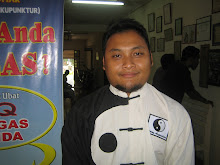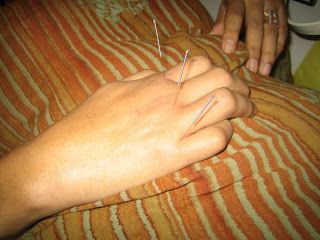
Homeopathy Hometruths
Yes to Doctor No
by Alison Nadel
A British Journalist From MAS Magazin
Photo: Dr Nik Omar & President International Homeopathic Medical League at
Oostense, Belgium May 2008
The waiting Room of Dr Nik Omar's clinic is busy. A school boy whose asthma cleared up within a day of homeopathic medicine has come back for some medicine to treat cold. A young woman is waiting for a pregnancy check up and to start a course of medicine for an easy birth. A man whose severe migraines vanished after being treat by Dr Nik six months ago, has dropped in to pick up a repeat prescription.
For them, there is no question that homeopathy works. Like many of Dr Nik's patients, they show little concern
about how or why it is effective. Only a few of the people in his waiting room say that they have come because homeopathy use natural substances. More stress the fact that it is cheap. One elderly man, partially paralysed and walking with a stick, says that since his last heart attack, there is nothing more that his doctor can do for him. Homeopathic is his last hope.
Dr Nik Omar does not fit the stereo type of the dedicated healer quietly pioneering his art. He is too bullish. Both his colleagues and his rivals acknowledge his tremendous energy. All recognize that he, more than any one, is responsible for raising the homeopathic medicine profile in Malaysia.
Dr Nik has written hundred of articles about his work. He is an active member of the international homeopathic community. In 1979 he set up his own version like the French Medical Volunteer Force, medicine sans frontier. He called his, Homeopathic Doctors Without Barrier. He says that his mission in life is to bring homeopathic medicines to every Malaysian man, woman and child.
Dr Nik has trainning in both western and homeopathic medicine. He studies both subjects for five years in Pakistan before going to Britain to train at London Foot Hospital, School of Chiropody, University College, London for two years.
Homeopathic has always been his primary interest. When he returned to Malaysia in 1977, it was homeopathic practice, not a chiropody clinic, that he set up in his home town of Kota Bharu.
Currently, he is conducting a study of infertility which brought one of his most celebrated successes. he calls of a a couple who has been married for 12 years without having children until in desperation, they came to see him.
" They have tried everything In-Vitro, IUI, GIFT and faith healer," he says, " Within only three months of councelling and homeopathic treatment, the women's pregnant was confirmed."
Dr Nik pepares his own medicine from ingredients imported from European countries, US, India and Pakistan. He has seen many miraculous in his treatment. The dosage are tiny and sweets. A standard homeopathic medicine is 'Sulphur' In its homoeopathic form a grain of sulphur is diluted in 99 parts of water and alcohol. This is its 'first potency'. A drop of that mixture is then diluted again in 99 parts of water and alcohol. This is it 'second potency'. This process is repeated until the 30 th potency. No trace of the sulphur remains. All that is said to be left are 'sulphur's medcicinal powers'.
Dr Nik does not, however, dismiss the need for conventional treatment. " No system of medicine has the right to claim it can cure everything, " he said. " If someone appendix is about to burst, they must go for immediate surgery. But if the disease is caught early enough, and treated with homeopathic, then surgery would became almost redundant."
Desspite of this claims being made by Dr Nik and numerous other homeopathic doctors in the world, homeopathy has yet to be welcomed by the orthodox medical establishment with open arms. In a country where alternative system of medicine proliferate, homeopathy suffers from being seen as just another treatment liking any scientific basis.
Such criticism is a sad fact of homeopathic life. Dr Nik treat it likely and points out that homeopathy has face of a long tradition of official opposition since it founder, Samuel Hahnemann was kicked out of Leipzig, nearly 200 years ago. For him the proof of the pudding is in the patients.
- From MAS Magazine, January 1996.























